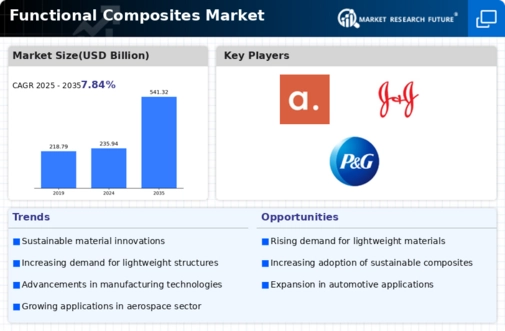Market Analysis
In-depth Analysis of Functional Composites Market Industry Landscape
The market dynamics of the functional composites industry are a reflection of various factors that influence supply, demand, and overall growth within the market. Functional composites, which are materials composed of two or more constituents with different physical or chemical properties, find applications across diverse industries such as automotive, aerospace, construction, and electronics. One of the key driving forces behind the growth of this market is the increasing demand for lightweight and high-performance materials. Industries such as automotive and aerospace are constantly seeking ways to reduce weight while enhancing strength and durability, driving the adoption of functional composites in these sectors.
Growing population and the increasing per capita disposable income in the developing nations are primarily driving the growth of the Functional Composites Market. Moreover, increasing demand for functional composites in the automobile and electronic industry mainly in countries such as India, China, and Japan is propelling the market growth.
Technological advancements play a significant role in shaping the market dynamics of functional composites. Innovations in manufacturing processes, such as additive manufacturing and automated production techniques, have led to improvements in the efficiency and cost-effectiveness of producing functional composites. These advancements have also enabled the development of composites with tailored properties to meet specific application requirements, further expanding the market potential.
Moreover, environmental concerns and regulations regarding emissions and fuel efficiency are driving the demand for lightweight materials in industries like automotive. Functional composites offer a viable solution by providing lightweight alternatives to traditional materials without compromising on performance. As a result, manufacturers are increasingly incorporating composites into their product designs to meet regulatory standards and consumer preferences for more sustainable products.
Global economic trends and geopolitical factors also influence the market dynamics of functional composites. Economic growth, particularly in emerging markets, drives demand for advanced materials in various industries, creating opportunities for market expansion. Additionally, trade policies and international agreements can impact the supply chain and pricing of raw materials essential for manufacturing functional composites, thus affecting market dynamics.
Competitive forces within the industry also shape market dynamics. As the demand for functional composites continues to rise, companies are investing in research and development to innovate new materials and manufacturing processes, leading to intense competition. Furthermore, mergers, acquisitions, and partnerships among industry players contribute to market consolidation and influence pricing strategies and market share distribution.
Consumer preferences and changing market trends also play a crucial role in driving the market dynamics of functional composites. As awareness of sustainability and environmental impact grows, there is a shift towards eco-friendly materials and products. Functional composites that offer recyclability and reduced carbon footprint are gaining traction in the market, prompting manufacturers to adapt their offerings to meet evolving consumer demands.
Furthermore, the COVID-19 pandemic has had both short-term and long-term effects on the functional composites market dynamics. Disruptions in supply chains, reduced demand from key industries, and economic uncertainties have impacted market growth in the short term. However, the pandemic has also accelerated certain trends such as the adoption of digital technologies for remote collaboration and manufacturing, which could have long-lasting implications for the industry.






Leave a Comment